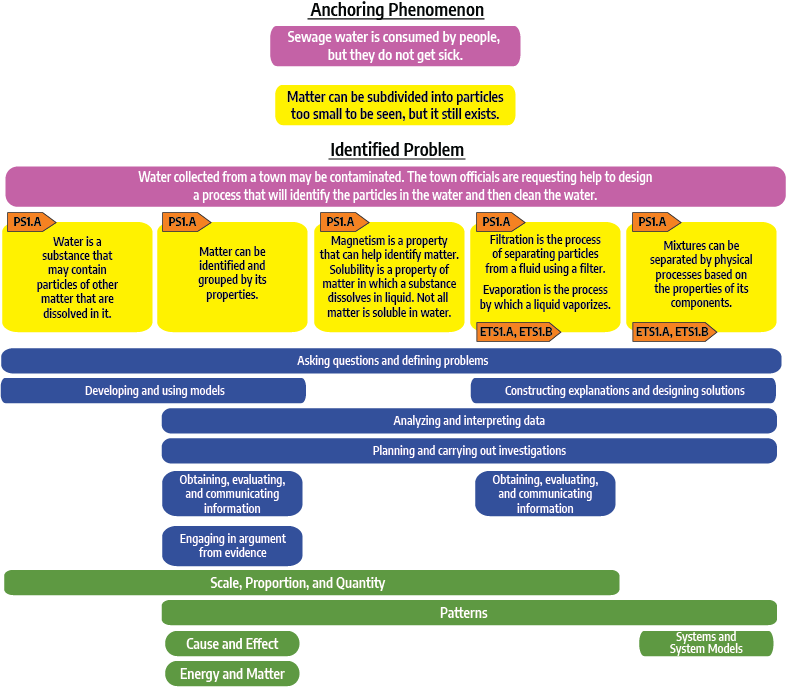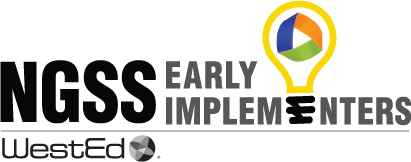
This engineering design learning sequence is built on the anchoring phenomenon: Sewage water is consumed by people, but they do not get sick. Students are introduced to water samples that have been gathered from a local town. The town hires the students to find out what is in the water and tell the town how to clean it. Students explore matter and its properties and discover that matter can be identified and grouped by its properties. Properties include size, shape, color, magnetism, conductivity, and solubility. They investigate quantifying matter by weight and volume. Using their understanding of physical properties, students design a solution, including a filtration system, to determine what is in the town water samples.
This unit builds towards these Performance Standards:
| PS1-2 | Measure and graph quantities to provide evidence that regardless of the type of change that occurs when heating and cooling, or mixing substances, the total weight of matter is conserved. |
|---|---|
| PS1-3 | Make observations and measurements to identify materials based on their properties. |
| 3-5-ETS1-1 | Define a simple design problem reflecting a need or want that includes specified criteria for success and constraints on materials, time, or cost. |
| 3-5-ETS1-2 | Generate and compare multiple possible solutions to a problem based on how well each is likely to meet the criteria and constraints of a problem. |

The Learning Sequence Narrative briefly describes what students do in each lesson and links the learning between the lessons as a conceptual storyline. As students progress through the learning sequence, they are making sense of designing a solution to the problem.
The identified problem for this learning sequence is: Water collected from a town may be contaminated. The town officials are requesting help to design a process that will identify the particles in the water and then clean the water. Students begin thinking about a solution to the problem by developing models of the town water samples and exploring the properties of the observable and unobservable matter in those samples. The properties students explore include magnetism, conducting electricity, solubility, and the quantities of matter in terms of weight and volume. Students then design a solution and evaluate the efficiency of processes to clean the water samples.
Students figure out this phenomenon by:
Asking Questions and Defining Problems
Developing and Using Models
Planning and Carrying Out Investigations
Analyzing and Interpreting Data
Constructing Explanations and Designing Solutions
Engaging in Argument from Evidence
Obtaining, Evaluating, and Communicating Information
PS1.A: Structure and Properties of Matter
ETS1.A: Defining and Delimiting Engineering Problems
ETS1.B: Developing Possible Solutions
Scale, Proportion, and Quantity
Patterns
Cause and Effect
System and System Models
Influence of Engineering, Technology, and Science on Society and the Natural World
Throughout the sequence, students drive the learning and are expected to be the architects of their own sensemaking. The teacher facilitates this process by offering opportunities for questions, supporting, and redirecting when necessary.
Throughout the sequence, a flag ( ) denotes formative assessment opportunities where instruction may change in response to students’ level of understanding and making sense of the problem. The sequence also provides direction when summative assessment opportunities arise.
) denotes formative assessment opportunities where instruction may change in response to students’ level of understanding and making sense of the problem. The sequence also provides direction when summative assessment opportunities arise.
The following Learning Sequence Narrative is based on the conceptual flow concept map above.
Identified Problem: Water collected from a town may be contaminated. The town officials are requesting help to design a process that will identify the particles in the water and then clean the water.
This lesson is the first in the sequence and is designed to engage students’ prior experience with contaminated water, elicit their questions about contamination from observations of a video and actual water samples, and generate investigation questions that will drive their learning through the next set of lessons. This lesson introduces the identified problem: Water collected from a town may be contaminated. The town officials are requesting help to design a process that will identify the particles in the water and then clean the water. In order to do this throughout the learning sequence, students will build on their prior knowledge that matter is made of particles too small to be seen, but even then, the matter still exists and can be detected by other means.
In this lesson, students use their investigation questions to identify the presence and amount of contamination, reinforcing the idea that particles that are too small to be seen still exist in the water. They continue to revise models and create new ones to explain their understanding. Students also review and add to their design questions to clean the water.
This lesson centers on students’ understanding that properties such as magnetism and solubility of matter can be used to identify unknown matter, and those properties can be useful in solving problems such as separating matter into categories for identification. They look for patterns, group the matter based on those patterns, and categorize the matter based on its properties. By using the properties of matter, students can begin to plan a design to solve the problem of separating and identifying the matter in the town water samples.
This lesson centers on students investigating new properties of matter (evaporation and filtration) to gather data and evidence. They strengthen their understanding that properties of matter can be useful in solving problems such as separating a mixture into its component parts. They use this evidence to plan a design solution for identifying and removing the unwanted materials from the town water samples. Students define criteria and constraints of the water problem as part of the engineering design.
This lesson centers on students using all the information they have gathered regarding the properties of matter to design a process or system to separate and identify the materials in the town water samples. Students will also evaluate their processes for success in meeting the criteria and constraints and compare their results to the results of other teams’ processes. By the end of this lesson, students will be closer to understanding the anchoring phenomenon that sewage water can be processed so that it is drinkable.
Christina Miramontes, 5th Grade teacher, Palm Springs USD
Jody Sherriff, Regional Director, WestEd/K–12 Alliance
Kimberly Trench, 5th Grade teacher, San Diego USD
Karen Weir-Brown, Middle School Teacher, Livermore Valley Joint Unified School District
Marin Silva, San Diego USD
Allison Collins, Palm Springs USD
Jennifer Kassel, Tracy USD
Achieve Science Peer Review Panel

A Collaboration of the K–12 Alliance @ WestEd, Aspire Public Schools, Galt JUSD, High Tech High, Kings Canyon USD, Lakeside USD, Oakland USD, Palm Springs USD, San Diego USD, Tracy USD, Vista USD, Achieve, and the California Department of Education
with funding from the S.D. Bechtel, Jr. Foundation and Hastings-Quillin Fund
The California K–8 NGSS Early Implementation Initiative was developed by the K–12 Alliance at WestEd with close collaborative input on its design and objectives from the California State Board of Education, the California Department of Education, and Achieve. This project was designed to build local education agency (LEA) capacity to fully implement the Next Generation Science Standards (NGSS) as a core subject in the elementary grades (K–5) and as the SBE’s preferred integrated model in grades 6–8.
The six-year Initiative provided teachers and administrators with in-depth, content-rich professional development to build leadership capacity and teacher acumen to deliver high-quality 3-dimensional learning for K–8 students. In addition, through collaborations among the K–12 Alliance, Achieve, and others, the LEAs in the Collaborative have opportunities to pilot test new NGSS-aligned tools, processes, assessment item prototypes, and digital and other instructional materials. The LEAs continue to serve as resources for NGSS implementation across California, and in other NGSS-adopting states as well.
This resource presents the conceptual storyline for a unit of instruction at a specific grade level, then focuses on a portion of the storyline called a learning sequence. The learning sequence uses the three dimensions of the NGSS (disciplinary core ideas–DCI; science and engineering practices–SEP; and crosscutting concepts–CCC) to build and deepen student understanding of natural phenomena and design challenges.
Participants in the CA NGSS K–8 Early Implementation Initiative developed and field-tested the lessons in the learning sequence.
NGSS Lead States. 2013. Next Generation Science Standards: For States, By States. Washington, DC: The National Academies Press.
A Framework for K–12 Science Education: Practices, Crosscutting Concepts, and Core Ideas. DOI: https://doi.org/10.17226/13165. National Research Council; Division of Behavioral and Social Sciences and Education; Board on Science Education; Committee on a Conceptual Framework for New K–12 Science Education Standards. National Academies Press, Washington, DC.